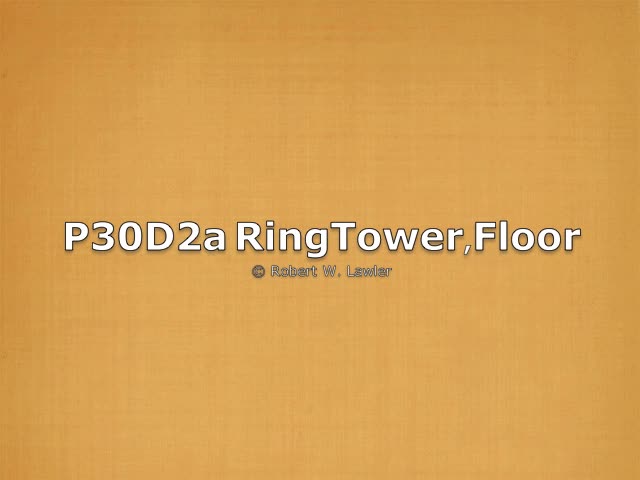
P030D2a Clip Notes
| Notes:n:nn | by Analyst, 9/17/2025 |
| Setting,Props | Cedar Hall, Family Room: set of rings on a right cylindrical stick/ tower |
| Actors,Aims | Peggy; Bob on camera , with Mom helping. |
| Episode A: [00:00:03] | Peggy: (on a large floor pad, bawling, in front of the mirror] Bob: Hey, Peggy [enters, puts Ring Tower in front of Peggy] Mom: [enters, pushes Ring Tower a little closer to Peggy] Bob: Peggy, have you ever seen one of those before, Peggy? Peggy: [crawls to it and starts removing rings] |
| Episode B: [00:00:23] | Bob: So she is lifting them off. That’s what she did the other day…. Let’s see if she shows any interest in putting them back on, eventually. |
| Episode C: [00:00:37] | Robby: [when a ring escapes Peggy’s sphere, he enters and returns it to her] Bob: Thank you, Robby. Robby: You’re welcome. Bob: In the future, though, if something gets away from her like that, why don’t we just let her do it? Just let it stay out of the way. |
| Episode D: [00:01:01] | Peggy: [makes a move with the tower which scatters rings about] Bob: Wow…. |
| Episode E: [00:02:00] | [from start of minute 2 through end of minute 4, there is no recorded speech: an action detailing opportunity] [00:04:48] |
| Episode F: [00:04:48] | Peggy: [begins crying, abandons the toys] Bob: Could you put the pole over closer to her? Mom: [does so, but Peggy continues crying]… Oh Peggy, What’s the matter? |
| Episode G: [00:05:15] | Bob: Well, why don’t you pick her up and give her a hug for a while? We’ll see if she wants to play later. [end] |
| Episode | |
| Summary by AI |
Scene set on a large floor pad with a mirror. Peggy is engaged with a Ring Tower toy, initially while upset/bawling. Bob prompts Peggy and observes her interaction with the toy. Peggy crawls to the Ring Tower and begins removing rings. Bob notes prior behavior and watches to see if she’ll try replacing the rings. A ring rolls away; Robby returns it to Peggy. Bob thanks Robby but advises letting items remain out of reach to encourage Peggy’s independent problem-solving. Peggy moves the tower, scattering rings; a prolonged period follows with silent action/observation (minutes 2–4). Peggy starts crying and abandons the toys; suggestion made to move the pole closer, but she continues crying. Bob recommends comforting Peggy with a hug and pausing play to try again later. |
| Narrative by AI |
In a recent home video, a young child named Peggy explores a classic ring-stacking toy on a floor mat, with family members nearby. At first, she eagerly removes the rings, showing clear interest in disassembly and experimentation. An adult, Bob, wonders aloud whether she might try placing the rings back on the pole, hinting at curiosity about her emerging problem-solving. A sibling, Robby, briefly steps in to return a ring that rolls away. The moment captures a common scene in early childhood: exploration, adult observation, and occasional assistance. What follows is a subtle balancing act between helping and letting the child lead. Bob thanks Robby for his help but suggests that it’s okay to let objects roll out of reach sometimes, allowing Peggy to contend with the consequences of her actions. This approach aligns with a common caregiving strategy: giving children room to navigate minor setbacks, which can foster persistence, attention, and motor planning. The environment remains supportive, yet the focus stays on Peggy’s own initiative and discovery. As Peggy continues to manipulate the toy, the rings scatter again—a natural outcome of trial-and-error play. There’s a quiet stretch where the adults observe without directing, offering space for Peggy to explore at her own pace. This pause is important; it respects the child’s process and may reveal emerging skills, such as intentional repetition, cause-and-effect learning, or attempts to reverse an action. Not every moment needs adult narration or correction for learning to occur. Eventually, frustration surfaces. Peggy abandons the toy and begins to cry, and an adult moves the pole closer in an effort to re-engage her. When that doesn’t help, the guidance shifts from task to comfort: pick her up, offer a hug, and try again later. This sequence underscores how emotional regulation is a key part of early learning. Recognizing when to step back from a challenge—and when to switch to soothing—supports long-term resilience and a positive association with problem-solving. Taken together, the scene offers a gentle snapshot of responsive caregiving. It highlights the value of letting children explore, the role of measured assistance, the importance of observing before intervening, and the necessity of comfort when frustration peaks. For parents and caregivers, the takeaway is simple: create safe opportunities for independent exploration, be thoughtful about when to help, watch for cues that signal a need for connection, and remember that learning often happens in the quiet spaces between attempts. |
| Link Index | Panel P030, Language Development, Object Exploration, Social Interactions |
| Themes, Interplay |
